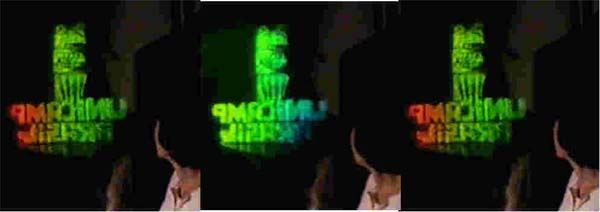![]()
"Enlarging Holograms Under White Light"
J.J. Lunazzi
ARTICLE PUBLISHED IN:
Proc. of the 17th Gral. Meeting of the International
Commission for Optics
Taejeon, Korea, 19-23.08.96
SPIE V 2778 p.469-470.
>>
![]()
We report the enlargement of holograms by illuminating with a halogen lamp from the small format of 35mm. A special configuration is employed to concentrate the luminous energy on the projection lens. An enlargement factor of 20 was obtained in a 75cm x 114cm holographic screen.
Introduction.
The enlargement of holograms under white light was previously reported by Lunazzi1,2,3, and by Lunazzi and Boone4,5, but xenon arc lamps or very efficient holographic materials were needed. We report here the achievement of a large enlarging factor (20x) starting from the very small format of 35mm using commercially available holographic film. The main principle for it is that, since the light diffracted by the hologram is projected through a lens, it can be directed to it avoiding the enormous lost of light that is not usually directed to the projecting aperture of the lens. We make the hologram by imaging through a lens having a centered horizontal slit. When reconstructing, a white light beam illuminates the hologram in the opposite direction of the reference wave direction so that the conjugated image is reconstructed. All of the white light whose wavelength matches that of the laser light is re-directed to the aperture, while other wavelengths are horizontally diffracted aside to it. A proper position exists to diaphragm the lens in order to project all wavelengths back to where the object was, and at this position a holographic screen is located to distribute wavelengths according to the original view from the object. Spectral distribution of views when reconstructing the hologram.
As shown in Figure1, the hologram H is reconstructed by a white light beam RC whose direction is opposite to that of the original reference beam. To differentiate the wavelengths of the rays on the figure, they were dashed with a period that is proportional to its corresponding wavelength, so that red rays has longer segments than green and blue rays. We can see how some positions on the lens L can receive all wavelengths, while others can only receive part of the spectrum. A vertical slit selects a sample of all wavelengths. We achieve in this way the projection of all the horizontal perspectives A, B, C received at the lens going through the slit to be projected at the holographic screen H and being redistributed on its original sequence to give the final image of the object O.

A holographic setup as for a usual "open aperture" hologram was employed using a lateral reference beam incident at 450, a 35mm photographic objective f=50mm , f:1.4 imaging small objects with a x1 magnification. The size of the image corresponded to the standard format for 35mm photography. A horizontal slit 3mm high was placed close before the objective. AGFA 8E75 holographic film was employed. When projecting, we substituted the original objective for another one, f=135mm, in order to obtain a larger distance from the hologram to avoid reflection of the transmitted beam at the inner of the projecting lens. We illuminated by means of a 300 W halogenous lamp. Fig.2 is a stereo photographic pair of the scene registered with a camcorder 8mm SONY video camera digitized by means of a TARGA+64 video card. It is shown in the format left view - right view - left view (L-R-L) so that the observer who wants to see it stereoscopically can choose the LR sequence for parallel observation, or RL for crossed observation. A 20% of lateral compression was performed to better fit the figure into text. The size of the holographic screen, a little larger than the size of the image, is 0.75m (H) x 1.14m (V) .

Figure 2: Stereo photographic pair of an enlarged hologram.
Conclusions.
We demonstrate the possibility of obtaining bright enlarged holographic images, an important step toward the development of holographic cinematography and for the reduction of size, weight and cost of holography. Although the method may be limited to small objects due to the difficulty in obtaining large aperture objectives, it is known that Komar and Serov5 could register the hologram of a person through such objectives.
Acknowledgements.
The author acknowledges to the National Council of Research - CNPq for the fellowships they received at the Senior and Student level, to the Foundation of Assistance to Scientific Research of the São Paulo State - FAPESP for the supporting of this project.
References.
[1] J.J. Lunazzi, Proc.of the SPIE meeting "Electronic Imaging", conference "Practical Holography VI", San Jose-CA-U SA, 9-14 Feb.1992, p.289-293.
[2] Private communication to E. Leith, F. Baumstein and M. Baumstein, 10 Oct. 1990 .
[3] J.J. Lunazzi, P.M. Boone, Opt. Lett.15 Nov.1994 p.1897-1899.
[4] J.J. Lunazzi, P.M. Boone, Proc. of the International Symposium on Display Holography, Lake Forest, 15-18 July 1994, p.449-453.
[5] V.G.Komar and O.B.Serov, Proc. of the "Holography '89" Intl.Conf., Y.N.Denisyuk, T.H.Jeong eds., SPIE, V1183, p.170-182 (1990).